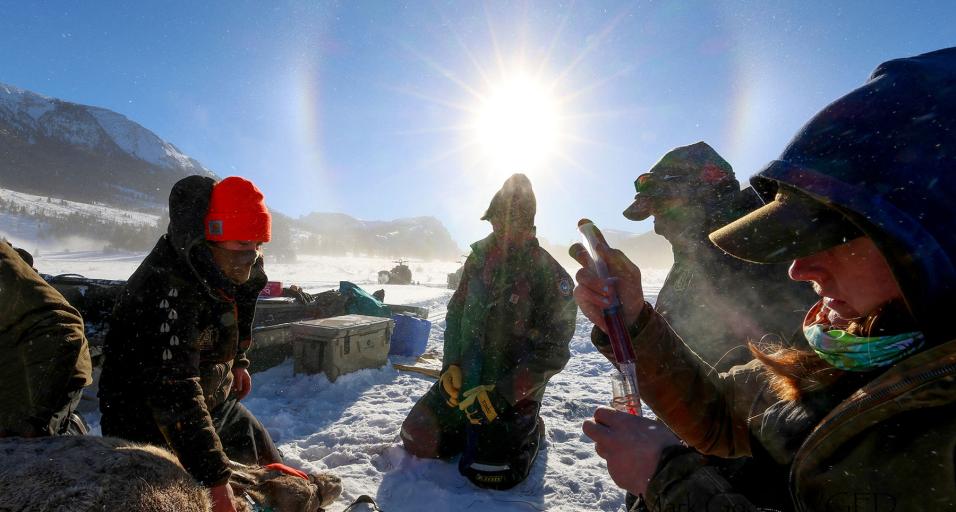Earlier this winter, the Wyoming Game and Fish Department, in cooperation with University of Wyoming wildlife researchers with the Monteith Shop, captured bighorn sheep in the upper Green River drainage north Pinedale to measure the animals’ body condition and assess the overall performance for this segment of the Whiskey Mountain herd. And what they’re finding is pretty surprising.
This is part of on-going research looking at three separate bighorn sheep herds, The Upper Shoshone herd in the Absaroka Range near Cody, the Whiskey Mountain herd in the Wind River Range between Dubois and Pinedale and the Jackson herd in the Gros Ventre Range near Jackson.
Dean Clause Pinedale Wildlife Biologist for the Wyoming Game and Fish Department and Rusty Kaiser Wildlife Biologist for the Bridger Teton National Forest take measurements on a ewe bighorn sheep on a cold morning near Lower Green River Lake earlier this winter.
Like many bighorn sheep herds across the West, these herds have struggled with pneumonia. However, not all sheep herds with pneumonia have responded the same – some experience a slow decline, some experience crash-recovery cycles and yet others show little decline at all. This research seeks to understand why the difference, and some indication is already being seen from within the same herd.
The Whiskey Mountain herd, once among the largest populations of Rocky Mountain Bighorn Sheep, has been in steady decline since the early 1990s, primarily due to pneumonia. The herd spans both sides of the Continental Divide in the northern Wind River Range. Although these sheep occupy the same general region of the Winds, researchers with the Monteith Shop have found distinct differences between the sheep on the Dubois side of the Divide vs. those on the Pinedale side.
Dr. Kevin Monteith (L) and University of Wyoming graduate student Brittany Wagler collar a ewe bighorn sheep and take other biological samples as part of their on-going research in the Upper Green north of Pinedale earlier this winter.
The sheep on the Dubois side move seasonally between high elevation summer range and low elevation winter range. These are common big game seasonal movements and typically these populations perform well. But habitat assessments have shown that these sheep have relatively poor summer forage, generally have to travel longer distances to get their calories and consistently have shown poor body condition when captured, which has led to very poor lamb survival.
However, the sheep on the Pinedale side of the Divide stay at high elevation year round, have much better summer forage, have been some of the fattest sheep researchers have monitored and have better lamb survival. Lambs that were captured in the Upper Green this winter had 11 percent fat, which is very impressive. And some of these ewes that spend year round in the high peaks are fatter, even after raising a lamb, than sheep from the Dubois-side that lost their lamb.
Bottom line, life for bighorn sheep in the Upper Green is looking pretty good when compared to their counterparts on the other side of the hill. And this research is providing Game and Fish managers more detailed information than they’ve ever had, which will lead to better management decisions for the sheep.



